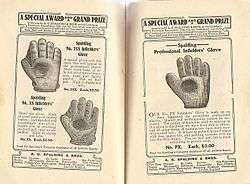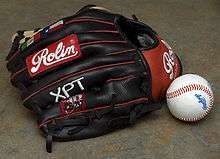Baseball glove
A baseball glove or mitt is a large leather glove worn by baseball players of the defending team which assist players in catching and fielding balls hit by a batter or thrown by a teammate.
By convention, the type of glove that fits on the left hand is called a "right-handed" or "RH" glove. Some websites and catalogs refer to these gloves as "Right-Hand Throw" gloves, meaning the glove is worn on the left hand. Conversely, a "left-handed" glove is worn on the right hand, allowing the player to throw the ball with their left hand.
History

Early baseball was a game played without gloves. During the slow transition to gloves, a player who continued to play without one was called a barehanded catcher. This did not refer to the position of Catcher, but rather to the practice of catching with bare hands. The earliest glove was not webbed and not particularly well suited for catching, but was used more to bat a ball to the ground so that it could be picked up.

One of the first players believed to use a baseball glove was Doug Allison, a catcher for the Cincinnati Red Stockings, in 1870, due to an injured left hand.[1] The first confirmed glove use was by Charlie Waitt, a St. Louis outfielder/first baseman who in 1875 donned a pair of flesh-colored gloves. Glove use slowly caught on as more and more players began using different forms of gloves.
Many early baseball gloves were simple leather gloves with the fingertips cut off, supposedly to allow for the same control of a bare hand, but with extra padding. First baseman Albert Spalding, originally skeptical of glove use, influenced more infielders to begin using gloves. Spalding later founded the sporting goods company Spalding, which still manufactures baseball gloves along with other sports equipment.[2] By the mid-1890s, it was the norm for players to wear gloves in the field.

In 1920, Bill Doak, a pitcher for the St. Louis Cardinals, suggested that a web be placed between the first finger and the thumb in order to create a pocket. This design soon became the standard for baseball gloves. Doak patented his design and sold it to Rawlings. His design became the precursor to modern gloves, and enabled Rawlings to become the preferred glove of professional players.[3]
For many years it was customary for fielders to leave their gloves on the field when their team went in to bat. This practice was prohibited by the major leagues in 1954.[4]
Baseball gloves have grown progressively larger since their inception. While catching in baseball had always been two handed, eventually, gloves grew to a size that made it easier to catch the ball in the webbing of the glove, and use the off-hand to keep it from falling out. A glove is typically worn on the non-dominant hand, leaving the dominant hand for throwing the ball; for example, a right-handed player would wear a glove on the left hand. By convention, the type of glove that fits on the left hand is called a "right-handed" or "RH" glove, although some websites and catalogs refer to them as "Right-Hand Throw", which means a glove which is worn on the left hand.
The shape and size of the baseball glove is governed by official baseball rules; Section 1.00, Objectives of the Game, defines limits of catcher's, first baseman's and fielder's glove in parts 1.12, 1.13 and 1.14.
The baseball glove has come a long way in over the past century. Today, gloves are made more precisely and more efficiently. There are still many advancements coming in the age of the baseball glove. Even today, Easton (Sporting good equipment company) is "experimenting with combining leather and Kevlar (used in bullet-proof vests) in a new ultra-light weight glove line".[2] Manufacturers have created different types of gloves to suit different types of people. Also, they have started personalizing gloves for certain players to increase exposure on national television. Rawlings sponsors more than 49.99% of the current MLB Players.[5] It is because of this dedication to gloves that the MLB has rewarded Rawlings with the "annual Rawlings Gold Glove Award, which has been presented to players for fielding excellence since 1957."
The highest-quality gloves are usually made of heavy leather that will need some time to break-in, provide a "snug" fit on your hand "right off the shelf" and typically do not have palm pads or Velcro adjustable wrist straps, which are excellent features to have if one is buying a youth or recreational type glove.
Most players choose which glove manufacturer they will sign with when they are in the minor leagues, and stay with them for their entire career.[5] Most glove companies will pay in the hundreds of thousands of dollars for high-caliber players to endorse their gloves.[5] Pitchers usually get the highest contracts for gloves because their glove is shown on television more frequently than other gloves.[5] One of the biggest endorsers of gloves was Roger Clemens, who won seven Cy Young Awards (awarded to best pitcher in each baseball league). His Cy Young Awards were won with three different glove companies.[5]
Even though there have been many advancements in the design and creation of the baseball glove, the greatest came in the invention of the catcher's mitt. However, a Wake Forest University study demonstrated, through 39 minor-league players, that even though today's catcher's mitts are state-of-the-art, they still do not offer enough protection from long-term injury to the hand and wrist.[2]

Varieties
The shape and size of a glove is described by its "pattern". Modern gloves have become quite specialized, with position-specific patterns:
- Catcher's mitts are called "mitts" because they lack individual fingers, like mittens. They have extra padding and a hinged, claw-like shape that helps them funnel 90+-mile-per-hour fastballs into the pocket, and provide a good target for pitchers. Some catchers use mitts with phosphorescent paint around the ridges to provide a clearer target for the pitcher. In addition, catcher's mitts come in single hinge and dual hinge varieties. If required to catch a knuckleball, a catcher will typically use an even larger mitt. Sizes of catcher's mitts, unlike those of other gloves, are measured around the circumference, and they typically have 32- to 34-inch patterns.
- First baseman's mitts also lack individual fingers. They are generally very long and wide to help them "pick or scoop" badly thrown balls from infielders. These mitts usually have 12.5- to 12.75-inch patterns, measured from wrist to the tip. Because first basemen are often left-handed, first basemen's mitts are readily available to fit on a right hand. Hank Greenberg is often credited as the first to wear this style of glove in the field.[6] Some catchers, such as Victor Martinez, use a first base mitt while catching knuckleballers.
- Infielders' gloves, unlike the first baseman's mitt, tend to be smaller. They have shallow pockets to allow fielders to remove the ball easily in order to make a quick throw to a base. Often the webbing will be open to allow dirt to move through the glove so that the infielder does not pull out a handful of dirt when trying to remove the ball from the glove. Infielder's gloves typically have 11- to 12-inch patterns, measured from the wrist to the tip.
- Pitchers' gloves usually have a closed, opaque webbing to allow pitchers to conceal their grip on the ball (which, in part, determines the behavior of the pitch in flight) from the batter. Pitcher-specific gloves tend to have 11.75- to 12-inch patterns; some pitchers such as Gio Gonzalez use gloves with patterns as large as 12.25 inches. Infield gloves with intricate webbing are also used by pitchers.
- Outfielder's gloves are usually quite long with deep pockets, to help with catching fly balls on the run or in a dive, and to keep outfielders from having to bend down as far to field a ground ball. These gloves typically have 12- to 12.75-inch patterns, measured from wrist to the tip. They are frequently worn-in differently from those of infielders, with a flatter squeeze rather than the infielder's rounded style.
- Switch-thrower's gloves are gloves with a second thumb pocket on the opposite side of the glove to allow it to be worn on either side of the hand, as used by switch-pitcher Pat Venditte.
Sizing
Baseball gloves are measured by starting at the top of the index finger of the glove and measuring down the finger, along the inside of the pocket and then out to the heel of the glove. Typically baseball gloves have a range from 9 inches (youth starter size) to 12.75 inches for adult outfield play.[7]
Major glove manufacturers
- Akadema
- Easton
- Hillerich & Bradsby, under the Louisville Slugger brand name
- Mizuno
- Nike, Inc
- Nokona
- Rawlings
- Spalding
- Vinci Co. LLC
- Wilson
References
- ↑ "Baseball 'Glove Affairs'". NPR. 4 September 2008. 27 June 2008.
- 1 2 3 Bennett, R. (2006, March 31). Glovology TCS Daily.
- ↑ Stamp, Jimmy. "The Invention of the Baseball Mitt". www.smithsonianmag.com. Smithsonian.com. Retrieved 27 April 2015.
- ↑ Feldman, Jay (February 20, 1984). "Of Mice And Mitts, And Of A Rule That Helped To Clean Up Baseball". Sports Illustrated.
- 1 2 3 4 5 Soyer, F. (May 1, 2001). "The Evolution of Baseball Gloves". Popular Mechanics.
- ↑ "Hank Greenberg" by Ralph Berger, The Baseball Biography Project
- ↑ Baseball Glove Sizing Charts
External links
- "How Products Are Made: Baseball Glove." www.science.enotes.com
- "Baseball Glove Leather"
- "Baseball / Softball Glove Buying Guide" www.homerunmonkey.com
- "How to size a baseball glove"
- "How to size a baseball bat"
- "MLB Rules 1.0".